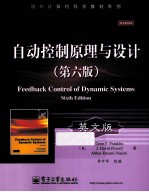图书介绍
自动控制原理与设计 第6版 英文版PDF|Epub|txt|kindle电子书版本网盘下载

- (美)富兰克林著 著
- 出版社: 北京:电子工业出版社
- ISBN:9787121191022
- 出版时间:2013
- 标注页数:590页
- 文件大小:52MB
- 文件页数:606页
- 主题词:自动控制理论-高等学校-教材-英文
PDF下载
下载说明
自动控制原理与设计 第6版 英文版PDF格式电子书版下载
下载的文件为RAR压缩包。需要使用解压软件进行解压得到PDF格式图书。建议使用BT下载工具Free Download Manager进行下载,简称FDM(免费,没有广告,支持多平台)。本站资源全部打包为BT种子。所以需要使用专业的BT下载软件进行下载。如BitComet qBittorrent uTorrent等BT下载工具。迅雷目前由于本站不是热门资源。不推荐使用!后期资源热门了。安装了迅雷也可以迅雷进行下载!
(文件页数 要大于 标注页数,上中下等多册电子书除外)
注意:本站所有压缩包均有解压码: 点击下载压缩包解压工具
图书目录
Chapter 1 An Overview and Brief History of Feedback Control1
A Perspective on Feedback Control1
Chapter Overview2
1.1 A Simple Feedback System3
1.2 A First Analysis of Feedback6
1.3 A Brief History9
1.4 An Overview of the Book14
Problems16
Chapter 2 Dynamic Response19
A Perspective on System Response19
Chapter Overview20
2.1 Review of Laplace Transforms20
2.1.1 Response by Convolufion20
2.1.2 Transfer Functions and Frequency Response25
2.1.3 The L_Laplace Transform32
2.1.4 Properties of Laplace Transforms34
2.1.5 Inverse Laplace Transform by Partial-Fraction Expansion36
2.1.6 The Final Value Theorem38
2.1.7 Using Laplace Transforms to Solve Problems39
2.1.8 Poles and Zeros41
2.1.9 Linear System Analysis Using MATLAB42
2.2 System Modeling Diagrams48
2.2.1 The Block Diagram48
2.2.2 Block Diagram Reduction Using MATLAB53
2.3 Effect of Pole Locations54
2.4 Time-Domain Specifications62
2.4.1 Rise Time62
2.4.2 Overshoot and Peak Time63
2.4.3 Settling Time64
2.5 Effects of Zeros and Additional Poles66
2.6 Stability76
2.6.1 Bounded Input-Bounded Output Stability76
2.6.2 Stability of LTI Systems77
2.6.3 Routh's Stability Criterion78
2.7 Historical Perspective87
Problems89
Chapter 3 A First Analysis of Feedback108
A Perspective on the Analysis of Feedback108
Chapter Overview109
3.1 The Basic Equations of Control109
3.1.1 Stability111
3.1.2 Tracking112
3.1.3 Regulation112
3.1.4 Sensitivity113
3.2 Control of Steady-State Error to Polynomial Inputs:System Type116
3.2.1 System Type for Tracking117
3.2.2 System Type for Regulation and Disturbance Rejection121
3.3 The Three-Term Controller:PID Control124
3.3.1 Proportional Control(P)125
3.3.2 Proportional Plus Integral Control(PI)125
3.3.3 PID Control126
3.3.4 Ziegler-Nichols Tuning of the PID Controller130
3.4 Introduction to Digital Control136
3.5 Historical Perspective141
Problems145
Chapter 4 The Root-Locus Design Method158
A Perspective on the Root-Locus Design Method158
Chapter Overview159
4.1 Root Locus of a Basic Feedback System159
4.2 Guidelines for Determining a Root Locus164
4.2.1 Rules for Plotting a Positive(180°)Root Locus166
4.2.2 Summary of the Rules for Determining a Root Locus171
4.2.3 Selecting the Parameter Value172
4.3 Selected Illustrative Root Loci174
4.4 Design Using Dynamic Compensation186
4.4.1 Design Using Lead Compensation187
4.4.2 Design Using Lag Compensation192
4.4.3 Design Using Notch Compensation193
4.4.4 Analog and Digital Implementations195
4.5 A Design Example Using the Root Locus198
4.6 Extensions of the Root-Locus Method204
4.6.1 Rules for Plotting a Negative(0°)Root Locus205
4.7 Historical Perspective208
Problems212
Chapter 5 The Frequency-Response Design Method228
A Perspective on the Frequency-Response Design Method228
Chapter Overview229
5.1 Frequency Response229
5.1.1 Bode Plot Techniques236
5.1.2 Steady-State Errors247
5.2 Neutral Stability249
5.3 The Nyquist Stability Criterion251
5.3.1 The Argument Principle252
5.3.2 Application to Control Design253
5.4 Stability Margins266
5.5 Bode's Gain-Phase Relationship273
5.6 Closed-Loop Frequency Response278
5.7 Compensation279
5.7.1 PD Compensation280
5.7.2 Lead Compensation280
5.7.3 PI Compensation292
5.7.4 Lag Compensation292
5.7.5 PID Compensation297
5.7.6 Design Considerations303
5.8 Historical Perspective305
Problems308
Chapter 6 State-Space Design328
A Perspective on State-Space Design328
Chapter Overview328
6.1 Advantages of State-Space329
6.2 System Description in State-Space331
6.3 Block Diagrams and State-Space338
6.3.1 Time and Amplitude Scaling in State-Space340
6.4 Analysis of the State Equations341
6.4.1 Block Diagrams and Canonical Forms341
6.4.2 Dynamic Response from the State Equations352
6.5 Control-Law Design for Full-State Feedback358
6.5.1 Finding the Control Law359
6.5.2 Introducing the Reference Input with Full-State Feedback367
6.6 Selection of Pole Locations for Good Design371
6.6.1 Dominant Second-Order Poles372
6.6.2 Symmetric Root Locus(SRL)373
6.6.3 Comments on the Methods382
6.7 Estimator Design382
6.7.1 Full-Order Estimators382
6.7.2 Reduced-Order Estimators388
6.7.3 Estimator Pole Selection392
6.8 Compensator Design:Combined Control Law and Estimator394
6.9 Introduction of the Reference Input with the Estimator407
6.9.1 A General Structure for the Reference Input408
6.9.2 Selecting the Gain418
6.10 Integral Control and Robust Tracking418
6.10.1 Integral Control419
6.11 Historical Perspective421
Problems424
Chapter 7 Nonlinear Systems444
Perspective on Nonlinear Systems444
Chapter Overview445
7.1 Introduction and Motivation:Why Study Nonlinear Systems?445
7.2 Analysis by Linearization447
7.2.1 Linearization by Small-Signal Analysis448
7.2.2 Linearizafion by Nonlinear Feedback453
7.2.3 Linearization by Inverse Nonlinearity453
7.3 Equivalent Gain Analysis Using the Root Locus454
7.3.1 Integrator Antiwindup460
7.4 Equivalent Gain Analysis Using Frequency Response:Describing Functions464
7.4.1 Stability Analysis Using Describing Functions470
7.5 Historical Perspective474
Problems476
Chapter 8 Control System Design:Principles and Case Studies483
A Perspective on Design Principles483
Chapter Overview484
8.1 An Outline of Control Systems Design485
8.2 Design of a Satellite's Attitude Control490
8.3 Lateral and Longitudinal Control of a Boeing 747507
8.3.1 Yaw Damper512
8.3.2 Altitude-Hold Autopilot519
8.4 Control of the Fuel-Air Ratio in an Automotive Engine525
8.5 Control of the Read/Write Head Assembly of a Hard Disk532
8.6 Control of RTP Systems in Semiconductor Wafer Manufacturing540
8.7 Chemotaxis or How E.Coli Swims Away from Trouble554
8.8 Historical Perspective562
Problems566
Appendix Solutions to the Review Questions579